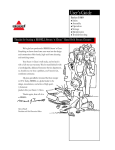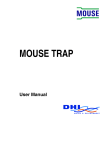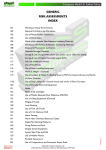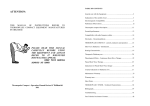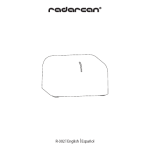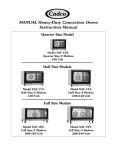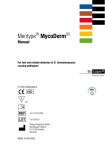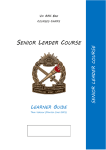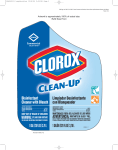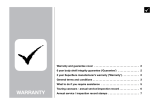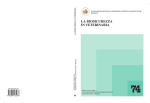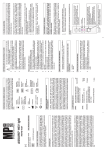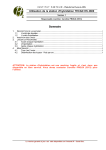Download Understanding Sanitizers and Disinfectants - Multi
Transcript
Technical Bulletin Understanding Sanitizers and Disinfectants A practical guide on how to select the appropriate germicide for your needs along with procedures for cleaning all types of facilities © 2007 Multi-Clean All rights reserved Introduction This Multi-Clean Technical Bulletin is designed to be a guide and reference manual that will help educate you and your staff on the importance on what germs are and why germicidal cleaners are needed. As housekeeping professionals, an important part of your job is to clean areas that require a high degree of cleanliness, such as restrooms, classrooms, hotel rooms, restaurants, medical facilities such as hospitals, nursing homes etc. The correct use of germicidal cleaners is required to achieve the desired level of cleanliness. Understanding how germcides work and which one to use are critical to your success. Information contained in this bulletin is designed to help you achieve your goal. Topics include: Types of germicides, chemistry of germicides, specific concerns in health care facilities, what the OSHA Blood borne Pathogen Act is and how to comply with it, how to choose the correct germicide, as well as cleaning procedures for different types of facilities. A brief description of many different microorganisms and why they are important, a quiz, and term definitions are also included for your convienience. Good Luck! Table of Contents Germs ................................................................................................................ 1 Types and Chemistry of Germicides ................................................................... 2 Specific Concerns in Health Care Facilities ........................................................ 3 OSHA Blood Borne Pathogen Act ....................................................................... 4 What is HBV, Hepatitis, AIDS? ........................................................................... 5 Choosing the Correct Germicide ..................................................................... 6-7 Cleaning Procedures ..................................................................................... 8-10 Significance of Bacteria, Fungi, and Virus’ ................................................... 11-12 Definitions .................................................................................................... 12-13 Quiz Time ......................................................................................................... 14 Multi-Clean Germicides .................................................................................... 15 How to sell Disinfectants to Hospitals ............................................................... 16 Four common mistakes made with germicides ................................... Back Cover Germs What is a Germ? The term “Germ” is a generic term used to describe microorganisms that can cause disease. These microorganisms can be bacteria, viruses, fungus, mold or mildew, all single cell organisms that can only be seen with the use of a microscope. See specific definitions of the different types of germs listed below. Bacteria: Microorganisms that do not depend on other organisms for survival. They can survive on surfaces for long periods, including door handles, sinks, mops, rags, countertops, cooking utensils, floors, bedposts, etc. Common examples of bacteria include Pseudomonas, Staphylococcus, Salmonella (hospital trio), Streptococcus, and E. coli. Viruses: Microorganisms that must attach itself to another organism (host) to survive. The do not survive on hard surfaces for long. Direct contact is required for these microorganisms to survive. Common examples of viruses include: Influenza, Herpes Simplex, HIV (AIDS), Rabies, and Canine Distemper etc. Fungus: A primitive plant that is parasitic (obtains nourishment from other living organisms) or saprophytic (feed on dead or decaying plant or animal material). Common examples of Fungus include: Yeast, Mushrooms, Bacteria, Molds, and Trichophyton (Athletes Foot). Mold and Mildew: Mold lives in the soil, on plants, and on dead or decaying matter. Molds are a fungus, and unlike plants, they lack chlorophyll and must survive by digesting plant materials, using plant an other organic materials for food. Molds produce tiny spores to reproduce, just a plants produce seeds. Molds have the potential to cause health affects, including alleries and asthma. Mildew is a living organism that grows with warmth, humidity, and nutrients. It is a thin, black or sometimes white, growth produced by mold. Common Molds include: Aspergillus. Spores: The reproductive element of certain microorganisms. Spores are generally dormant and can survive for long periods of time, sometimes years and are very difficult to kill. Spores can be thought of as being similar to a seed of a plant. The seed (or spores) will not germinate until they are planted in the ground and the conditions are favorable for growth, such as warmth (spring sun), moisture (rain), and food (fertilizer). Spores are generally not killed by most disinfectants. See pages 11-12 for a list of germs and what diseases they cause. Good “Non-Pathogenic” Microorganisms vs. Bad “Pathogenic” Microorganisms All microorganisms do not cause disease. There are many helpful germs called Non-Pathogenic Microorganisms. In fact, we could not live without non-pathogenic microorganisms. For example: you could not digest your food without the bacteria present in your stomach. Some fungi (yeast) help make food such as bread, beer, wine, or spirits. Bacteria break down dead organic material (compost piles). Molds are used to make medicines, such as penicillin. However, many other germs can make people sick and even cause them to die. These are called pathogenic germs. The pathogenic germs are the ones we need to control and stop their growth before they make people sick. How do germs live? All microorganisms require three things to grow and multiply: 1) Food Source: Almost any carbon based material will suffice: Food, grease, dirt, body oils, soaps, dirty mop buckets solutions, rotted wood, damp cotton, … Microorganisms will eat most anything! 2) Moisture: High Humidity in shower rooms, flood or sewer back-ups, solution tanks on auto scrubbers, wet mops, leaky sinks, wet carpets, etc. 3) Warm Environment: 75°F – 85°F is optimum. Microorganisms can survive in environments ranging from 45°F – 150°F (7-65°C). How do germs cause infection or disease? The successful invasion and growth of germs in the tissues of a person’s body is called an infection. For an infection to occur, a series of three steps must happen: 1. Germs must be present 2. Germs must be transported to the body. 3. Germs must enter the body. Germs are everywhere: In the air, in food, on the floor, on surgical instruments, all non-sterile surfaces including peoples bodies. However, germs can only cause infections in one place, our bodies. Germs do not have the ability to move by themselves. They must be transported to our bodies. Germs can travel through the air on dust, on animals, by insects, in water, by other people, directly or indirectly. Shaking hands would be an example of direct transportation of germs. An example of indirect transportation would be an infected person passing the germs to an object, say a door handle, and then another person touches the door handle. Infections can’t occur until the germs enter our bodies. Germs enter our bodies through our mouth, nose, eyes, ears, or any open wound. This commonly happens when germs that are on our hands get transported to the mouth, eyes or nose through normal activity, such as wiping a nose, rubbing eyes, sneezing etc. When germs enter the body, they destroy our tissues and emit poisons that the body absorbs. These poisons cause disease. Microorganisms can reproduce, by doubling every 15-20 minutes or so. Theoretically one germ at 8 AM can multiply to over 76 billion germs by 5 PM under optimum conditions. This quick ability to multiply is why we must constantly keep cleaning and disinfecting places where these germs can live and come in contact with humans. Different levels of germ control There are different levels of sanitation that are used to reduce or kill microorganisms depending on the need. Sanitization: Reduces germs to a safe level, as judged by public health standards. Sanitizing must reduce the number of germs by 99.99%. While 99.99% sounds like it should be good enough, it still can leave a significant number of germs on a surface. There can be several billion germs on a dirty surface, such as a dirty plate. If you have 5,000,000,000 germs on a surface, and you are able to take away 99.99% of them, you are left with 500,000 germs on the surface. Again, sanitization reduces germs to safe levels. Disinfection: Kills 100% of the germs claimed on a disinfecant label when used as directed. It does not kill spores. Sterilization: Will eliminate 100% of all germs and their spores. This is accomplished by the use of autoclaves. Autoclaves are equipment that use high heat and pressure to kill any germs and spores. 1 Types of Germicides Germicides can come in many different forms. • Ready to Use: Aerosol (Foaming & Non-Foaming), Non-Aerosol (usually with a trigger sprayer) • Concentrated, ¼ ounce per gallon, up to 28 ounces per gallon of water. • Hospital Grade Disinfectant: Must have claims to kill Pseudomonas aeruginosa, Staphylococcus aurous & Salmonella choleraesuis (the hospital trio) as a minimum. • Institutional Disinfectant (schools, industry, hotels etc.) Must have claims to kill Staphylococcus aurous & Salmonella choleraesuis as a minimum. Chemistry of Germicides Quaternary Ammonium Chlorides (Quat) • Low level disinfection. • Most common type of disinfectant and sanitizer. • Many different grades of quats, each with its own specific advantages/claims. • Can be Hospital Grade or Institutional Grade (or both depending on dilutions) • Pleasant odor, not medicinal (like phenolics). Easy to formulate different fragrances into. • Great Cleaner. Can be formulated with detergents and builders to make disinfectants “One Step Cleaner and Disinfectant.” • Can be used on food contact surfaces. • Can be formulated into neutral, acid, or alkaline-based cleaners/disinfectants. • Not effective against TB (Tuberculosis) by itself. There is a dual quat/solvent blend disinfectant on the market that is effective against TB such as Multi-Clean’s Microcide TB. Phenolics • Intermediate level disinfection. • Effective against TB • Medicinal Fragrance. • Moderate Cleaning ability. • Effective in Hard Water • Not to be used of food contact surfaces. • Harsh on floor finishes. • Used at ½ - 2 ounce per gallon. Bleach • Bleach has no cleaning ability. All surfaces to be disinfected must be pre-cleaned first before disinfecting or sanitizing. This makes it a two step process. • Strong chlorine odor. • Bleach can damage some surfaces, including floor finishes. • Solutions may be inactivated by organic soil and sunlight. Must be made fresh each day. • Must use at 10% dilution (12 oz per gal). • Inexpensive concentrated. Expensive in diluted state. • Form: 5 ½% Sodium Hypochlorite Solution (household bleach). Compare Quats - Phenolics - Bleach Quat Phenolics Bleach General Care Areas Critical Care Area (ICU, E.R., etc.) General Care Areas Not effective for TB** Effective against TB ????? Excellent Cleaner Moderate Cleaner NO CLEANING ABILITY Must pre-clean surfaces before disinfecting. Pleasant Fragrance Medicinal Fragrance Strong Chlorine Odor May be used on food preparation Surface May NOT be used on food contact surfaces May be used on food Contact Surfaces. Tested in the presence of organic soil Tested in the presence of organic soil. Inactivated by organic soil. Stable when diluted Stable when diluted Unstable. Solutions Must be made up before each use. Moderte cost per gal. (Concentrate) High cost per gallon (Concentrate) Low cost per gallon (Concentrate) Low cost when diluted Moderate cost when diluted. High Cost when diluted. 1/2 oz - 2 oz per gal. (1:256 - 1:64) 1/2 oz - 2 oz per gal. (1:256 - 1:64) 12 oz per gallon. (1:10) READ THE LABEL FOR PROPER DILUTIONS ** One exception would be Multi-Clean’s Microcide TB. 2 Specific Concerns in Health Care Facilities Super Germs Antibiotic resistant “Super Germs” are a significant concern to health care related facilities. These bacteria have developed resistance against treatment with common antibiotics and are easily transmitted. In some hospitals, particularly in intensive care units and nursing homes, where antibiotic use is often highest, there is a higher prevalence of these resistant germs. These Super Germs are more difficult to treat as we have fewer antibiotics with which to treat them. MRSA and VRE MRSA and VRE are two common bacteria that have developed this resistance. MRSA: Methicillin Resistant Staphylococcus aureus. VRE: Vanomycin Resistant Enterococcus (formerly called Streptococcus faecalis). MRSA has been plaguing hospitals for years, and the only effective treatment has been another antibiotic called vancomycin. However, in 1988, another “super bug” began appearing in hospitals, which is resistant to vancomycin. VRE are extremely communicable, and have a 40% mortality rate. Remember, however that these germs have become resistant to antibiotics, not disinfectants. The difference between antibiotics and disinfectants is like the difference between hunting with a bow & arrow and hunting with a bazooka. An antibiotic is designed to enter the living body and target a specific cellular target, e.g. a particular site in an enzyme. Just one slight change, a simple mutation, and the germs will become resistant to the antibiotics. Quat disinfectants however, are nonspecific in their attack. They attach to anything anionic in nature like the bacterial protein (i.e. the amino, carboxyl or phosphate groups) that surrounds the bacteria. The quat by surrounding the bacteria disrupts the charges on the cell wall causing a change in charge distribution (disorganization/denaturing). This disruption causes a subsequent release of the intracellular material or autolysis to take place. Thus the cell is killed. Nosocomial Infections Contracting an infection/ailment while in a hospital for something else. Example: Go into hospital to have a gall stone removed, and contact a urinary tract infection. Statistics show that there is a 5-10% chance of contracting a nosocomial infection when you enter a hospital. Urinary Tract, Surgical Wound, and Lower Respiratory Infections are the most common types of infections contracted while staying in the hospital. Nosocomial infections affect over 1,000,000 people each year. Infection Control Committees Committees in hospitals and health care facilities, made up of doctors, nurses and/or administrators that are responsible for controlling the spread of infections. These committees decide and approve what disinfectants and cleaning methods are to be used for each part of their medical facilities. 3 OSHA Bloodborne Pathogen Act What is the OSHA Blood Borne Pathogen Act? The Bloodborne Pathogen Act was created by OSHA (Occupational Safety and Health Administration) to reduce the number of cases of infectious Hepatitis B and HIV (AIDS) transmitted form infected blood and body fluids in the workplace. It covers any employee who may be exposed to infected blood and body fluids. Health care workers are particularly affected. In the early 1980’s, OSHA knew very little about HIV (AIDS) and HBV (Hepatitis B Virus), two relatively new bloodborne pathogens at that time. However, they new that thousands of health care workers were getting sick form these viruses and some were dying. Due to this, OSHA determined that they needed to implement a law to help protect workers from these pathogens. The OSHA Bloodborne Pathogen Act was instituted on December 6, 1991. Under the Act, employers must: 1. Develop a written exposure control plan including: a) The determination of which employees may be exposed. b) Procedures for evaluation the circumstances of an exposure. c) A schedule and methods for implementing the plan. 2. Provide information and training for each employee covered by the act. 3. Vaccinations for infectious hepatitis must be made available to all employees covered by the Act. 4. Established engineering and work practice controls to reduce exposure to the potentially infected fluids. Personal protection and equipment may also be covered. Proper housekeeping, including the use of appropriate disinfectants, is also required. Containers and equipment holding potentially infected blood or body fluids must be labeled accordingly. 5. If an exposure incident occurs, a medical evaluation and follow-up must be made available to the exposed employee. 6. Records must be kept for each employee covered by the Act. Medical training records are required. What products are approved for use by the OSHA Bloodborne Pathogen Act. Originally only chlorine and tuberculocidal (TB) disinfectants were approved for use in disinfecting blood and body spills. Quaternary based disinfectants were not approved to meet the OSHA Bloodborne Pathogen Act standards. In the early 1980’s, little was known about HBV and HIV. They did not know how difficult it was to kill HBV and HIV. Since TB was already known to be a very difficult virus to kill, OSHA decided to pick it as a standard. They assumed that if a disinfectant could kill TB, it would also be effective against HBV or HIV. This caused lots of confusion as people assumed that this standard had something to do with TB. TB can only be transmitt by airborne particles from a person infected with TB who coughs and then is inhaled someone who is nearby and inhales these airborne particles deep into their lungs. TB is not transmitted by blood, body fluids or from any hard surfaces. Since then, research has shown that the HBV and HIV viruses are actually fairly easy to kill. The only problem was that the only EPA approved test for HBV involved testing on chimpanzees. Chimpanzees are not only an endangered species, but testing for HBV on chimpanzees is costly and required that 50 chimpanzees would need to be destroyed. In August 2000, the EPA approved an alternate protocol for HBV, not requiring the use of any chimpanzees. Since then, many companies have submitted thier quaternary based disinfectants and sanitizers for testing with this new protocol. Now, most quaternary based disinfectants have claims to kill Hepatitis B virus (HBV), Hepatitis C virus (HCV) and HIV-1 (AIDS). Most quaternary based disinfectants comply with the OSHA Bloodborne Pathogen Act. They are suitable for low level disinfection of surfaces contaminated with blood or bodily fluids. Read the label of all disinfectants to be sure they have claims to kill HBV, HCV and HIV-1 before using to clean up blood or body fluids. 4 What is HBV? Hepatitis B Virus (HBV) is a virus that attacks the liver and can cause lifelong infection, cirrhosis (scarring) of the liver, liver cancer, liver failure, and death. About 30% of infected persons have no signs or symptoms. Symptoms are less common in children than adults and can include: jaundice, fatigue, abdominal pain, and loss of appetite, nausea, and vomiting and joint pain. HBV is transmitted when blood or body fluids from an infected person enters the body of a person who is not immune. Sexual contact, sharing needles with an infected person, or from an infected mother to her baby during birth are other ways to contract HBV. World wide it is estimated that there are over 350 million Hepatitis B carriers which represents 5% of the world’s population. HBV is responsible for killing about one million people each year. It is estimated that 10 to 30 million people become infected with the virus each year. HBV is very common in Asia, China, Philippines, Africa, and the Middle East. In Europe and North America, the incidence of known Hepatitis B carriers is about 1 in a 1000 people. Infected persons can be lifelong chronic carriers of the disease. There is no known cure although there are some medications to treat long lasting HBV (which are effective for only 40% of infected persons). The good news is that vaccinations are available for HBV. Other Hepatitis Virus’s Hepatitis A virus (HAV) is a less serious liver disease caused by the Hepatitis A virus (HAV). HAV can affect anyone and is spread through food or water. HAV must be ingested and then is shed in the feces. HAV is usually present in unsanitary conditions or when poor hygiene is used by food servers. There is no known treatment of Hepatitis A. It generally lasts from a few days to a few weeks and leaves the person immune to Hepatitis A. Hepatitis C virus (HCV) can cause cirrhosis (scarring) of the liver. Infected persons can be lifelong chronic carriers of the disease. No vaccinations are available for HCV. Most cases of HCV identified recently are found in people who were infected years ago. Since blood banks are screening potential donors, very few new cases have been identified. What is AIDS? AIDS stands for Acquired Immune Deficiency Syndrome. AIDS is caused by a virus called HIV (Human Immunodeficiency Virus). If you get infected with HIV, your body will try to fight the infection. It will make “antibodies”, special molecules that are suppose to fight HIV. When you get a blood test for HIV, the test is really looking for these antibodies. If you have these antibodies in your blood, it means that you are HIV-Positive. Being HIV-Positive is not the same as having AIDS. Many people are HIV-Positive but don’t get sick for many years. As HIV continues, it slowly wears down the immune system. Viruses, parasites, fungi, and bacteria that don’t usually cause problems can make you very sick when your immune system is damaged. The blood, vaginal fluid, semen and breast milk of people infected with HIV has enough of the virus in it to infect other people. You can get HIV from anyone who’s infected, even if they don’t look sick, and even if they haven’t tested positive. Most People get the HIV virus by having sex with an infected person, sharing a needle with someone who’s infected, being born to an infected woman, or drinking the breast milk of an infected woman. Getting a blood transfusion of blood from an infected blood donor used to be a way people got AIDS, but now the blood supply is screened very carefully and the risk is very low. Once infected, the virus will multiply in your body for a few weeks or even months before your immune system responds. During this time, you won’t test positive, but you can infect other people. When your immune system responds, it starts to make antibodies. When you start making antibodies, you will test positive for HIV. There is no cure for AIDS. There are drugs that can slow down the HIV virus; however there is no way to get all the HIV out of your body. For more information, go to the Center for Disease Control (CDC) web site at: http://www.cdc.gov 5 Choosing the Correct Disinfectant Many factors must be considered when choosing the correct germicide for you applications. Each disinfectant will have different properties that must be evaluated. Below are some of the areas that need to be considered to make an intelligent choice. Questions to ask before selecting the correct germicide These questions must be answered in order to be sure that you have selected the correct product • Do I need to disinfect or sanitize? • Do I need a disinfectant & cleaner or a product to disinfect/sanitize surfaces that have been already pre-cleaned? • What organisms do I need to control? • What is the proper contact time for this germicide? • What is the proper dilution or activity level? • If cleaning up blood or body fluids: • Is this OSHA Blood Borne Pathogen Act compliant? • Is it effective against HIV, HBV and or HCV? • Is the germicide effective in Hard Water? • Is the germicide tested in the presence of Organic Soil? • What pH does the germicide need to be? • How expensive is the germicide? • Is the germicide registered with the EPA? How about the state it is being used in? READ THE LABEL!!! What microorganisms do I need to control? Do you want to control bacteria from handling raw meat or eggs, or how about mold and mildew in shower rooms, or HIV and HBV in medical facilities, or cleaning up after a basement floods from a sewer back-up, or cleaning up vomit in a school or cleaning a hallway vinyl tile floor with floor finish? Each of these scenarios has their own specific needs and requires a specific germicide to handle a specific problem. You must know what you are trying to accomplish and then checking the germicide label to determine if it has efficacy against these germs. Efficacy is the ability to destroy a specific, claimed germ. All disinfectants must undergo strict laboratory tests to prove that it is effective against each germ that it has made claims for. These results are then submitted to the EPA for review, before the label is approved. The label will also list “directions for use” that will include proper dilution, contact time, and any pre-cleaning steps that may be required. It is important to know what types of germs you are concerned about and if a germicide will be able to make the claims that it will be effective against these germs. If a germ is not listed on the label of a disinfectant, do not assume that the product will kill that specific germ (the health inspectors won’t). READ THE LABEL!!! What is the proper contact time for this germicide? Each germicide will state how long it must remain in contact with a surface to achieve the full efficacy of the stated claims. Generally, a 10 minute contact time is standard for most quat germicides. Spray and wipe cleaning generally is not sufficient for full disinfecting. Mopping a floor and letting it air dry generally is sufficient contact time, as most floors will take about 10 minutes to dry. You must read the “directions” or “procedures” section of the label to determine the proper dilution and contact time to get the full benefits of the germicide. READ THE LABEL!!! What is the proper dilution or activity level? Every germicide will either be ready-to-use or they will be concentrated and must be diluted. Proper dilution of concentrated is important to get the full benefit of the germicide. By using a dilution higher that what is recommended, either by intention or by accident (glug, glug), you do not get any additional benefit. It will only be more expensive as you will purchase more chemical that you really needed. Know the activity level or ppm (parts per million) of active ingredients for germicidal cleaners. The % of active ingredients are found on the label and be translated into ppm by simply using this formula: % of active ingredient x 10,000 dilution rate of product = 15 x 10,000 = 586 ppm 256 1/2 oz./gal. = 256 (1:256) 1 oz./gal. = 128 (1:128) 2 oz./gal. = 64 (1:64) Knowing the quat ppm active is important because the effectiveness can deteriorate as the quat germicidal solutions become dirty. The ppm of quat in a mop bucket or spray bottle can be easily tested with test strips that are dipped into a germicide solution and then compared to a color chart on the test kit that will translate into % active PPM quat. READ THE LABEL!!! Is this germicide effective in Organic Soil? Some germicides are not effective on dirty surfaces. Some germicides are inactivated in the presence of organic soil (such as bleach). All germicides should be effective in at least 5% Organic soil (blood serum). READ THE LABEL!!!. Is this germicide effective in Hard Water Some quat disinfectants are not effective in hard water. Look at labels to determine if your quat germicide has been tested to be effective in at least 400 ppm CaCO3. READ THE LABEL!!! 6 Choosing the Correct Disinfectant (Continued) What pH does the germicide need to be? Germicides come in many different pH ranges. The pH of a germicide will be listed on the literature sheet and the Material Safety Data Sheet for that product. It is important to know the pH of the germicide and how it will affect the surface to which it is being applied. pH is a unit of measure. The pH scale is 0-14 and measures the amount of acidity or alkalinity in a solution. Acid Germicides: pH 0-6 are generally effective in restroom cleaning. Acids are useful for dissolving mineral deposits(hard water), soap scum, and rust stains in sinks, shower rooms, and toilet bowls etc. Neutral Germicides: pH 7 - 8 are generally used for daily cleaning of vinyl tile and terrazzo floors sealed with acrylic floor finish. Neutral Cleaners will not harm the shine and leaves no residue when used properly. Alkaline Germicides: pH:8-14. Generally, the higher the pH, the better cleaning, and degreasing properties a cleaner/germicide will have. However. cleaner/germicides over pH 10 can be harmful to floor finishes. Battery Acid 0 Lemon Juice 1 Strong Acid Bowl Cleaners Orange Juice 2 Shower Cleaners 3 Shampoo Water Baking Soda Coke 4 5 Mildly Acidic 6 Carpet Debrowners 7 8 Neutral Laundry Detergent 9 Mildly Alkaline Neutral Germicides 10 Ammonia 11 12 Caustic Soda 13 Strong Alkaline All Purpose Germicides 14 Floor Strippers How expensive is this germicide? Never choose a germicide based on the cost per gallon of concentrate. Always focus on the end use cost which is calculated using this formula: $ per gallon concentrate = End use cost $ dilution rate Example: Compare end use cost of a ½ ounce per gallon hospital disinfectant at $25.60 per gallon vs. a 2 ounce per gallon hospital disinfectant at $12.30 per gallon. $23.50 / 257 = $0.09 per gallon, diluted $12.30 / 65 = $0.19 per gallon, diluted 257 = 1:256 = ½ oz. per gallon 65 = 1:64 = 2 oz. per gallon As you can see, the ½ oz/gal disinfectant at $23.50 is more economical to use than the 2 oz/gal. product at $12.30/gal. ($0.09 vs. $0.19 per gallon diluted). This end use cost will tell you how much it costs every time you use the product. This cost is much more important than the price per gallon of concentrate. Make sure your germicidal product is EPA registered. Every pesticide (including disinfectants and sanitizers) sold in the United States must be registered with the Environmental Protection Agency (EPA). The EPA registration number can be found on the label. In addition, each manufacturer must register each pesticide in each state that the pesticide will be sold in. This registration must be renewed every year. Distributors should check with the manufacturers to verify that every disinfectant they are selling is properly registered for the states they are selling into. The cost of registering each disinfectant in all 50 states can be expensive, so some manufacturers choose to register their disinfectants regionally or only in states where they expect to sell them. READ THE LABEL!!! Safety This is a rather broad area, but is extremely important to the user. Employees charged with the responsibility of using disinfectant products expect and deserve products that will not be detrimental to their health. If the product does have potential for health concerns (i.e., skin irritation), the proper protective equipment should be available and utilized by those using the product. One of the most common safety complaints about disinfectants is the fumes given off by the product when used. Typically this will be caused by three reasons: 1. Mixed too strong: User failed to follow the label directions and either used too much product or too little water. READ THE LABEL!!! 2. Used hot water. Increasing the water temperature will cause rapid evaporation of the product, fragrance and/ or the disinfectant ingredients causing respiration and eye irritation. USE COLD OR WARM WATER. 3. Aerosolize: Most “above the floor” cleaning is done with hand held spray bottles filled with a solution of the disinfectant. It is common for users to dial the nozzle to the “fine“ spray, then when the user sprays the product to clean a mirror, for example, the fine spray is in the user’s “breathing zone” and this irritates the nostrils and mucous membranes. In extreme cases, this could lead to a serous respiratory problem. USE COARSE SPRAY or use a rag bucket method. Immerse the rag in the bucket containing the disinfectant and then wring out the rag prior to cleaning a surface. 7 Cleaning Procedures The following pages have recommended cleaning procedures for many different types of facilities. While every facility has different cleaning procedures, these recommendations can be used as either a starting point for developing a procedures manual for a new facility or it may be of use to compare to current cleaning procedures to determine if existing cleaning procedures are optimized or could be updated to be more efficient. 1. Classrooms Assemble all product and equipment items. Place wet floor signs. Put on disposable gloves. 2. Empty all trash receptacles and damp wipe with cloth and germicidal cleaner. Allow to air dry. Replace plastic liner. 3. Erase chalk boards, white boards, and partitions and clean with appropriate cleaner. 4. Damp wipe ledges, vents, and sills (if applicable) with cloth and germicidal cleaner and let air dry. 5. Damp wipe top of desks and chairs (if applicable) with cloth and germicidal cleaner and let air dry. 6. Vacuum surfaces (if applicable) with back pack vacuum. 7. Dust mop floor (if applicable). 8. Damp mop floor (if applicable) with germicidal cleaner and let air dry. 9. Spot clean carpet (if applicable) with carpet spot cleaner. 10. Vacuum carpet (if applicable). Products Required: Germicidal Cleaner Carpet Spot Cleaner Equipment • Trash Can Liner • Cleaning Cloths • 24” Dust Mop • 16 oz. wet mop • Mop bucket • Dust pan • Counter brush • Disposable gloves Recommended Multi-Clean Products: Ful-Trole 64, Microcide TB, GTS Foaming Disinfectant Cleaner, Super Staph-Trole 256 or Century Q 256 Restrooms 1. Evacuate toilet bowls. Apply bowl cleaner to interior and under rim of toilet bowels and urinals. Move to step 2 (do not flush). 2. Empty trash and wipe out receptacles as needed. 3. Sweep Floor 4. Restock supplies: toilet paper, towel dispenser, soap dispensers, sanitary napkins etc. 5. Clean the exterior of all dispensers, hand dryers, fixtures, and baby changing stations, etc. Lightly spray surface with germicide, then with a clean cloth. 6. Clean sinks, porcelain surfaces and chrome with germicidal cleaner. 7. Clean walls and partitions especially near stools and urinals. 8. Clean mirrors with glass cleaner and a lint free cloth. 9. Return to toilets, urinals and spray exterior porcelain surface and fixtures with germicidal cleaner and wipe. 10. Swab interior surfaces with bowl mop, then flush. 11. Damp mop floor with germicidal cleaner from bucket starting at rear of restroom and working toward the exit. Recommended Multi-Clean Products: Fresh 100 Non-Acid Bowl Cleaner, 950 Bowl Cleaner, 2300 Bowl Cleaner, Ful-Trole 64, Microcide TB, GTS Foaming Disinfectant Cleaner, Multi-Shine Glass and Surface Cleaner and/or Ful-Trole 64 1. 2. 3. 4. 5. 6. 7. 8. Nursery Assemble all product and equipment items. Place wet floor signs. Put on disposable gloves. Empty trash receptacles and damp wipe with germicidal cleaner. Re-line with plastic liner. Damp wipe sill, ledges, vents, exterior of light fixtures, furniture with cloth and germicidal cleaner. Spot clean walls with cloth and germicidal cleaner. Clean nursery observation windows with cloth and glass cleaner. Replenish supplies as needed. Dust mop floors with clean dust mop. Damp mop floors with clean mop and germicidal cleaner. Recommended Multi-Clean Products: Ful-Trole 64, Microcide TB or GTS Foaming Disinfectant Cleaner, Multi-Shine Glass and Surface Cleaner, Super Staph-Trole 256 and/or Century Q 256. 8 Products Required: • Germicidal Cleaner • Glass Cleaner • Toilet Bowl Cleaner (Acid and/or NonAcid) Equipment • Trash Can Liner • Cleaning Cloths • 24” Dust mop • 16-24 oz. Wet mop • Wet floor signs • 4-6 gal. mop bucket • Dust pan • Counter brush • Hand Soap, paper towels, Toilet paper • Disposable gloves Products Required: • Germicidal Cleaner • Glass Cleaner Equipment • Trash Can Liner • Cleaning Cloths • 24” Dust Mop • 24 oz. wet mop • Wet floor signs • 4-6 gal. mop bucket • Dust pan • Counter brush • Auto scrubber • Scrub Suit, shoe covers • Face Mask • Hand Soap, Paper Towels, Toilet paper, etc. • Disposable gloves Cleaning Procedures, con’t Critical Areas (O.R., I.C.U., Recovery Rooms): For Cleaning Between Patients 1. Assemble all product and equipment items. Place wet floor signs. Products Required: 2. Prepare to enter area by donning scrub suit, shoe covers, facemask, and disposable Germicidal Cleaner gloves. Equipment 3. Scrub rooms and halls are a part of the sterile area and should be cleaned with a • Trash Can Liner germicidal cleaner, in the same manner as the rest of the surgery areas. • Cleaning Cloths 4. Empty all trash receptacles and clean receptacles inside and outside with germicidal • 24” Dust Mop cleaner. Replace plastic liners. • Auto Scrubber or 5. Dust mop floor using clean dust mop. • 16 oz. wet mop 6. Preclean soiled areas. Check closely, as many times there will be blood spots that • Mop bucket are hard to see. For complete wash down, dip wall mop in germicide cleaner, wring • Dust pan mop dry and wipe all walls and ceilings. Let air dry. • Counter brush 7. Wipe lightly over table on inside and outside with germicidal cleaner. Lights can be • Scrub Suit moved down for better cleaning. • Shoe Covers 8. Using high dust tool spritzed with a germicidal cleaner, clean lights, vents, clock, • Face Mask light rails, etc. Use ladder to get light tracks and rails in ceiling. • Disposable gloves 9. Damp wipe all ledges, electrical cords, light switches, cabinet door tracks, stools, stands, with a germicidal cleaner and let air dry. 10. Move all equipment that can’t be removed to one side of the room. Mop or autoscrub floor with germicidal cleaner and let air dry. Move equipment to other side of room and clean the opposite sides of the floor. 11. In scrub rooms, thoroughly clean sinks with germicidal cleaner. Clean plumbing fixtures above and below the sink with cloth and germicidal cleaner and let air dry. Other metal apparatus, such as soap dispensers, should be thoroughly cleaned with a germicidal cleaner. 12. Damp wipe hamper stands in scrub area with germicidal cleaner and set in fresh hamper bag. After completion of workday, equipment must be wiped down with a germicidal cleaner and let air dry. After disinfecting, wipe dry with a clean rag and leave in surgery/delivery for the next day’s use. Do not remove any housekeeping equipment from sterile surgery area. Products Required: Recommended Multi-Clean Products: PHD-257 (Phenolic Hospital Disinfectant) • Germicidal Cleaner • Carpet Spot Cleaner Emergency Rooms, Out Patient Clinics Equipment 1. Assemble all product and equipment items. Place wet floor signs. Put on • Trash Can Liner disposable gloves. • Cleaning Cloths 2. Empty wastebaskets and damp wipe with cloth and germicidal cleaner*. • 36-48” Dust Mop Replace liners. • 24 oz. wet mop 3. Damp wipe horizontal surfaces with cloth and germicidal cleaner. • Wet floor signs 4. Spot clean vertical surfaces with cloth and germicidal cleaner. • Upright vacuum cleaner 5. Damp wipe litters, wheel chairs, etc. with cloth and germicidal cleaner. with attachments 6. Clean bathrooms as per procedure on page 14. Replenish all disposable • 4-6 gal. mop bucket supplies, i.e. toilet paper, paper towels etc. • Dust pan 7. Clean all glass areas with cloth and germicidal cleaner. • Counter brush 8. Polish all stainless steel and bright metal surfaces with cloth and germicidal • Hand Soap, paper cleaner. towels, toilet paper, etc. 9. Dust mop floors (if applicable) using clean dust mop. • Disposable gloves 10. Damp mop floor (if applicable) using germicidal cleaner and let air dry. 11. Spot clean carpet (if applicable) using carpet spot cleaner. 12. Vacuum carpet (if applicable). Recommended Multi-Clean Products: Ful-Trole 64, Microcide TB, GTS Foaming Disinfectant Cleaner, PHD-257 (Phenolic Hospital Disinfectant), Super Staph-Trole 256 and/or Century Q 256 Products Required: • Germicidal Cleaner • Absorbent Blood-Body Fluid Spills Equipment 1. Assemble products and equipment and post wet floor signs. • Cleaning Cloths 2. Put on disposable gloves, goggles, mask and gown. • 24” Dust mop 3. Blood and body fluids must be thoroughly cleaned from surfaces and objects • Gloves, gown, goggles, before application of disinfectant. Absorb spill completely with absortant. Pick face mask. up absorbed material with spatula and place in bio-hazard bag. • 16-24 oz. Wet mop 4. Disinfect surfaces and objects with germicide cleaner that is OSHA Blood Born • Wet floor signs Pathogen Compliant. Follow instructions on label for correct contact time (usually • 4-6 gal. mop bucket 10 minutes). • Dust pan 5. Bag cleaning supplies contaminated with blood or body by products separate • Counter brush and dispose of immediately using the proper procedure for waste elimination. • Bio-Hazard Bags 6. Wash hands after removing gloves with an antibacterial hand wash. • Spatula Recommended Multi-Clean Products: • Absorbant Microcide TB, GTS Foaming Disinfecant Cleaner, Super Staph-Trole 256, PHD 257 (Phenolic • Disposable gloves Hospital Disinfectant) and/or Multi-Fresh Antibacterial Hand Cleaner. 9 Cleaning Procedures, con’t Patient Room-Occupied 1. Assemble all product and equipment items. Put on disposable gloves. 2. Knock before entering room. 3. Empty all waste receptacles and damp wipe with cloth and germicidal cleaner. Replace liners. 4. Remove soiled linens. 5. Spritz high duster with a gemicidal cleaner. High dust tops of lights, doors, curtains, blinds, etc. and let air dry. 6. Damp wipe ledges, over-bed tables, bedside stands, desk tops, telephones, charts, door frames, and closets with cloth and germicidal cleaner and let air dry. 7. Spot clean walls with cloth and germicidal cleaner. 8. Damp wipe bed frame and mattress with cloth and germicidal cleaner and let air dry. 9. Clean restroom as outlined on page 10. 10. Dust mop floor with clean dust mop. 11. Place wet floor signs to keep traffic out of area to be damp mopped. 12. Damp mop floor with clean mop and germicidal cleaner, let air dry. 13. Make up fresh germicidal solution every 4 rooms or when dirty. Products Required: • Germicidal Cleaner Equipment • Trash Can Liner • Cleaning Cloths • 18” Dust Mop • 16-24 oz. wet mop • Wet floor signs • 4-6 gal. mop bucket • Dust pan Recommended Multi-Clean Products: Ful-Trole 64, Microcide TB, GTS Foaming Disinfectant Cleaner, Super Staph-Trole 256, Century Q 256 Patients Room-After Discharge 1. Assemble all product and equipment items. Put on disposable gloves. 2. Remove all soiled linens (if applicable) from the room, bed and restroom, and place in the soiled linen hampers provided for that area. 3. Empty all waste receptacles and damp wipe with cloth and germicidal cleaner. Replace liners. 4. Spritz high duster with germicidal cleaner. Dust tops of lights, doors, curtains, blinds, etc. 5. Damp wipe ledges, shelves, over-bed lights, over-bed tables, (inside and out), bedside stands (inside and out), desk tops, chairs, telephones, door frames, and closets (inside and out) with cloth and germicidal cleaner and let air dry. 6. Spot clean walls with cloth and germicidal cleaner. 7. Using germicidal cleaner and damp cloth, completely disinfect the bed and mattress working from top to bottom. Apply germicidal cleaner directly into hard to reach areas, including corners, wheels. Let air dry. 8. Remake bed with clean linens according to requirements for that particular area. Place restroom linens in appropriate location. 9. Clean restroom as outlined on page 10. 10. Dust mop floor (if applicable) with clean dust mop. 11. Place wet floor signs to keep traffic out of area to be damp mopped. 12. Damp mop floor (if applicable) with clean mop and germicidal cleaner and let air dry. Make up fresh germicidal solution after every 4 rooms or when dirty. Products Required: • Germicidal Cleaner Equipment • Trash Can Liner • Cleaning Cloths • 18” Dust mop • 16-24 oz. Wet mop • Wet floor signs • 4-6 gal. mop bucket • Dust pan • Counter brush • Hand Soap, paper towels, Toilet paper • Disposable gloves • High Duster • Linens Recommended Multi-Clean Products: Ful-Trole 64, Microcide TB or GTS Foaming Disinfectant Cleaner, Super Staph-Trole 256, Century Q 256 Whirlpool Baths 1. If the whirlpool bath has soap scum and/or mineral deposit build-up, do the following procedure before using the disinfectant. 2. Use a phosphoric acid or similar cleaner* to clean the soap scum and/or mineral deposit build-up. Use a brush or non-abrasive pad to help remove stubborn build-ups. 3. Rinse with water. To Disinfect Whirlpool Baths, 1. After using the whirlpool unit, drain and refill with fresh water to just cover the intake valve. 2. Use appropriate amount of an approved germicidal cleaner as directed on label. Start the pump to circulate the solution. Wash down the unit sides, seat of the chair lift and any/all related equipment with a clean swab, brush, or sponge. Treated surfaces must remain wet for 10 minutes. 3. Repeat for heavy soiled units. 4. Drain germicide solution. 5. Rinse. Recommended Multi-Clean Products: Phos-Clean Bowl and Tile Cleaner, Ful-Trole 64 Disinfectant Cleaner 10 Significance of Specific Bacteria Acinetobacter calcoaceticus: Occurs in soil, water, and sewage. A Nosocomial infection in compromised patients leading to septicemia, meningitis, abscesses, and urinary tract infections. Bordetella bronchiseptica: Normal resident of canine respiratory tracts, sometimes causing “kennel cough.” Transmitted by coughing and sneezing. Chlamydia psittaci: Common to domestic mammals. Can cause abortions in domestic mammals. Ornithosis (parrot fever) and psittacosis. Human chlamydial infections can result from exposure to domestic mammals, but they are uncommon. Enterobacter aerogenes & cloacae: Can cause bacteremia urinary tract infection, post-surgical wound infection, and other nosocomial infections. Occurs in water, sewage, soil, dairy products, feces of man and animals. Most strains resistant to ampicillin. Escherichia coli: A nosocomial infection that causes urinary tract infections, terminal septicemia, “travelers diarrhea” and infant diarrhea. Fusobacterium necrophorum: Causes hoof rot in cattle, sheep, and horses. May infect man. Klebsiella pneumoniae: Causative agent of pneumonia. Causes infant diarrhea and urinary tract infections. Listeria monocyrogenes: Food poisoning, listeriosis, meningitis and abortion. Pasteurella multocida: Causative agent of fowl cholera. Humans become infected from dog and cat bites in which abscesses can develop around the wound and then cause septicemia (blood poisoning). Pseudomonas aeruginosa: Has ability to survive and multiply in fluids, water and moist environments found in hospitals. Hospital acquired infections usually occur to patients having prior instrumentation or manipulative procedures such as urethral catheterizations, tracheostomies, and intravenous infusions of medications and fluids. The most important human sources are infected wounds, urine, and lesions producing exudates. Causes infant diarrhea, ocular infections, burn infections, cystic fibrosis, folliculitis, osteomyelitis and malignant external otitis. Proteus mirabilis & vulgaris: Causes urinary tract infections, infant diarrhea, and respiratory tract infections. Salmonella choleraesuis: Causes gastroenteritis, septicemia, bacteremia, and arthritis. Most common cause of bacterial diarrhea in the United States. Samonella enteritidis: Food poisoning (salmonellosis), septicemia, diarrhea. People can become carriers. Salmonella typhi: Causes typhoid (enteric) fever. Organisms enter the body via contaminated food and water, invading the intestinal tract. Salmonella typhimurium: Invades intestinal tissue and enters the blood stream causing enterocolitis and chronic gallbladder infections. Serratia marcescens: Can cause cystitis, bloodstream and central nervous system infections. May be associated with nosocomial and antibiotic resistant infections. Shigella flexneri & sonnei: Causes bacillary dysentery; characterized by severe cramping, abdominal pain and diarrhea with blood and mucus. Staphylococcus aureus: Causes skin infections such as cellulitis, boils,carbuncles, impetigo, and postoperative wound infections. Can cause food poisoning and toxic shock syndrome. Both community and hospital acquired infections such as bacteremia, endocarditis, meningitis, pneumonia, and osteomyelitis. Staphylococcus epidermis: Causes bacteremia, infective endocarditis, peritonitis associated with dialysis and predominantly genitourinary tract infections. Streptococcus faecalis: Group D occurs in the neonatal period. Anatomical defect in the central nervous system, neurological intervention, endocarditis, urinary tract infections may lead to meningitis. Streptococcus pyogenes: Beta-Hemolytic Group A. Transmission from person to person usually from close contact by an asymptomatic carrier colonized in the nasopharynx, skin, angina, or rectum. It may be transmitted by contaminated food. Causes pharyngitis, tonsillitis, sinusitis, arthritis, etc. After five weeks of pharynageal infection, rheumatic fever, scarlet fever, or impetigo may occur. Significance of Specific Fungi Candida albicans: A sexual budding yeast that is a normal flora of the throat. Causes vaginal infections. Trichophyton mentagrophytes: A fungus that is the common cause of athlete’s foot (interdigitale). 11 Significance of Specific Virus’s Adenovirus, Type 4: Causes less than 5% of acute respiratory diseases. It is spread from person to person. Avian Infectious Bronchitis: An acute, rapidly spreading viral respiratory infection of chickens. Canine Distemper: A highly contagious disease among dogs causing fever, gastrointestinal and respiratory problems. Feline Leukemia Virus: This virus is demonstrated in cats with lymphosarcoma. It appears in the mouth of infected cats and is passed from cat to cat. Feline Picornavirus: Feline calicivirus is the synonym. Produces a respiratory disease, conjunctivitis, and vesiculation in the mouth of cats. Hepatitis B Virus: Hepatitis B Virus (HBV) is a virus that attacks the liver and can cause lifelong infection, cirrhosis (scarring) of the liver, liver cancer, liver failure, and death. Herpes Simplex Type 1: Virus causing fever blisters and canker sores caused by colds. Herpes Simplex Type 2: Causes lesions on penis, urethra, vulva, vagina, and skin of buttocks. Human Immunodeficiency Virus: Causes severe damage to the human immune system often leading to death. The virus that causes AIDS infects white blood cells and T-helper cells that play key roles in body’s immune system. Infectious Bovine Rhinotracheitis: Inflammation of the upper respiratory tract. If occurs with bacterial infection may cause bronchial pneumonia. May invade the placenta and fetus via maternal blood stream causing abortions or stillbirths. Causes encephalitis in 2-3 month old calves, also oral & gastric necrosis in newborns. Influenza Virus, Type A/HK: Virus that causes the flu. An acute respiratory disease that occurs in epidemic form. Transmitted from person to person via aerosol route (coughing and sneezing). Pseudorabies Virus: Causes an acute viral infection of the central nervous system in mammals, primarily in swine. Rabies: Virus that enter the human body via animal bites. Symptoms begin with partial paralysis, then paralysis (becomes more general) hydrophobia (fear of water) sets in when throat muscle spasms occurs and air ducts become hypersensitive. If untreated, the patient will go into a coma and die. Respiratory Syncytial Virus: A paramyxovirus that is the principal cause of pneumonia and bronchiolitis in small children and infants. Transmitted person-to-person by droplet and aerosol from the respiratory tract. Highly contagious. Rubella Virus: Causes German Measles. Transmissible Gastroenteritis: Causes profuse diarrhea, vomiting and dehydration swine. High mortality in first month of newborn. Outbreak generally in early Spring and Winter. Vaccinia: Pox virus used for vaccination of man for immunity against small pox. Definitions Antimicrobial Agent - Chemical with destroys or inhibits the growth of microbes. Antiseptic - Compounds with bactericidal properties that are designed for application on living tissue. A.O.A.C. - Association of Official Analytical Chemists. An organization that publishes a manual which contains the approved test procedures which must be used in establishing data to be submitted the EPA for registration. A.O.R.N. - Association of Operating Room Nurses. An association formed to streamline procedures and increase levels of sanitation in operating rooms. Their publications and the association are recognized by all hospital organizations. A.P.I.C. - Association for Professionals in Infection Control and Epidemiology. Their mission is to influence, support, and improve quality of healthcare through practice and management of Infection Control and the application of Epidemiology in all health care settings. Asepsis - The state of being free from pathogenic microorganisms. Bactericidal - The property of killing bacteria. Bacteriostatic - Inhibiting the growth of bacteria. CDC - Center for Disease Control. A division of the Department of Health, Education, and Welfare. web site: http://www.cdc.gov An excellent source of information on disease and heath related topics. Contact Time - The time a disinfectant or sanitizer must remain in contact for full efficacy of stated claims, generally 10 minutes. Must read label to obtain this information. 12 Definitions, con’t Culture - A growth of microorganisms in nutrient media; the process of growing microorganisms. Disinfection - The destruction of 100% of claimed pathogenic organisms. Efficacy Data - The ability to destroy a specific, claimed germ as tested by the A.O.A.C Use Dilution Test for disinfectants. EPA - Environmental Protection Agency. The federal branch of government responsible for the registration of pesticides. Fungus: Multi-Cellular organisms including molds, mildews, and mushrooms. Reproduction is accomplished through the formation of spores. Germicide - Chemical compounds which kills microorganisms, i.e. sanitizers, disinfectants, and sterilants Gram-Negative bacteria - A classification of bacteria which, due to it’s cell wall composition, becomes pink in color when stained according to the Gram Test Staining Procedure. Gram-Negative bacteria are generally pathogenic (disease causing). Gram Positive - A classification of bacteria which, due to its cell wall composition, becomes purple in color when stained according to the Gram Test Staining Procedure. Gram positive are generally non-pathogenic (does not cause disease). Hard Water - Water which contains high levels of calcium and magnesium. Hard water can inactivate some quat disinfectants. Must read labels to determine if disinfectants were tested in hard water. Hospital Grade Disinfectant - Disinfectants which have been proven effective against three organisms: Staphylococcus aureus, Salmonella choleraesuis, and Pseudomonas aeruginosa (the hospital trio). Incubation - A period of time required for microorganisms to develop as described in the A.O.A.C use dilution test. Institutional (General) Disinfectant - A disinfectant with efficacy claims against Staphylococcus aureus and Salmonella cholerasuis (not Pseudomonas aeruginosa). Mold & Mildew - Forms of fungus. Molds lack chlorophyll and must survive by digesting plant materials, using plant and other organic materials for food. Molds produce tiny spores to reproduce. Mildew is a living organism that grows in warmth, humidity and nutrients. It is a thin, black or sometimes white growth produced by mold. One Step Cleaner/Disinfectant - A product capable of cleaning lightly soiled surfaces and disinfecting them in one step. With out this claim, a pre-cleaning step is required. No Rinse Sanitizer - Sanitizer used in food processing plants, not rinsed after use. Non-Pathogenic organism - A non-disease causing organism. Non pathogenic bacteria can be used in carpet, odor digesters, trap & drains, sewage treatment plants, etc. Odor Causing Bacteria - Bacteria that emit foul-smelling waste products, such as Proteus Vulgaris. Pathogen - A disease causing organism. Phenol - Carbolic Acid. Phenol derivatives are used in disinfectant compounds. Originally extracted from coal tar, they are produced synthetically today. PPM - Parts per million. Also can be stated as milligrams per liter. Quat - Shortened name for quaternary ammonium compounds. These surfactants are the active ingredients used in the manufacturing of quat based disinfectants. The active ingredients destroy or disrupt the cell wall of microorganisms. Sanitizer - A chemical which will kill 99.99% of claimed organisms. Normally done in food processing facilities. Spores - The reproductive element of certain microorganisms. Spores are generally dormant and can survive for long periods of time, sometimes years and are very difficult to kill. Sterilize - To kill 100% of all germs and their spores. Tuberculocidal Disinfectant - A disinfectant with efficacy again the mycobacterium organism (TB). USDA - United States Department of Agriculture. In charge of regulating meat and poultry processing facilities. Virus - A microorganism which reproduces only within other living cells. 13 Disinfectant Quiz Time 1. What does Pathogenic Organism mean? a. Disease causing b. non-disease causing 10. Nosocomial Infections are defined as.....? a. Contracting an infection while in the hospital for something else. b. Contracting an infection while at home sleeping. c. Contracting an infection while working in a meat processing plant. d. Contracting an infection while in an airplane 2. What do microorganisms need to live, grow and multiply. a. warmth b. moisture c. food d. all of the above 11. Under the Bloodborne Pathogen Act, Employers are required to offer vaccinations to covered workers for what disease? a. HIV b. Salmonella c. HBV d. MRSA 3. How often do bacteria reproduce under optimum conditions a. every minute b. every 15 -20 minutes c. every hour d. every day 4. Disinfection will kill what percent of claimed germs a. 50% b. 90% c. 99.99% d. 100% 12. How long should a germicide stay in on a surface for full efficacy? a. As long as it takes to clean the surface. b. Each germicide is different, you must read the label. c. Until break time is over. d. Until the foam goes away 5. Sanitizing will kill what percent of claimed germs. a. 50% b. 90% c. 99.99% d. 100% 13. What is the pH of a Neutral Germicide? a. 1 b. 3 c. 7 d. 10 6. Bleach is a good cleaner? True / False 14. Alkaline Cleaners/germicides are good at cleaning up hard water deposits. T / F 7. Quats are excellent cleaners? True / False 8. Phenolic germicides are effective against TB. T/F 15. Two (2) ounces per gallon is what ratio? a. 1 : 2 b. 1 : 10 c. 1 : 64 d. 1: 256 9. Hospital Grade Disinfectants must have efficacy claims for what three bacteria? a. Pseudomonas aeruginosa, Staphylococcus aureus and Salmonella choleraesuis b. Eschericia coli, Proteus vulgaris and Candida albicans c. MRSA, VRE and HBV. d. HIV, Herpes Simplex II and Trichophyton mentagrophytes 16. Every germicide sold in the U.S. must be registered with what U.S. government department? a. OSHA (Occupational Safety & Health Administration) b. FDA (Food and Drug Administration) c. USDA (United States Dairy Association) d. EPA (Environmental Protection Agency Quiz Answer Key: 1-A, 2-D, 3-B, 4-D, 5-C, 6-False, 7-True, 8-True, 9-A, 10-A, 11-C, 12-B, 13-C, 14-False, 15-C, 16-D. 14 Multi-Clean Germicides Ful-Trole 64 Multi-Purpose Cleaner, Disinfectant & Deodorizer: Hospital Grade Disinfectant when used at 2 ounces per gallon of water and a Institutional Grade Disinfectant when used at 1 1/4 ounces per gallon of water. MultiPurpose restroom cleaner. Bactericidal (Including: Pseudomonas, Staphylococccus, Salmonella, Streptococcus, MRSA, VRE), Virucidal (HIV-1, HBV, HCV), Fungicidal (including: Tricophyton) and Mold and Mildew. Effective in 400 ppm hardness (calculated as CaCO3) in the presence of 5% Organic Serum. Lemon or Floral scents. pH: 12.0-12.4. EPA Registration Number: 10324-80-5449. Century Q 256 Disinfectant/Cleaner: Health Care Disinfectant. A neutral pH, 1/2 ounce per gallon, hospital grade cleaner/disinfectant. Use on high gloss finished floors, without dulling. Broad Spectrum efficacy including HBV, HCV, MRSA, VRE and HIV-1 (AIDS VIRUS). Also effective against Canine Parvo when used at 2 oz/gallon. See Technical Bulletin for complete list). Floral fragrance, EPA Registration Number 10324-141-5449. Fresh 100 Non-Acid Disinfectant Bowl Cleaner: Hospital grade, ready-to-use disinfectant cleaner for restroom maintenance. Its germicidal formula and clinging action makes this exceptional for toilet bowel and urinal sanitation. It is effective against Pseudomonas aeruginosa, Staphylococcus aureus, Salmonella choleraesuis (the hospital trio), Streptococcus pyogenes, Trichophyton interdigitale, Influenza Type A , Herpes Simplex Type II, and HIV-1 (AIDS). Citrus/Fresh Fragrance, pH: 10.8 - 11.0, EPA Registration Number: 47371-97-5449. GTS Foaming Disinfectant Cleaner: An advanced foaming aerosol cleaner/disinfectant. This high foam formula uses unique solvents and surfactants to aggressively cleans any surface without abrasives. Phenolic based, OSHA Bloodborne Pathogen Act compliant, ready-to-use aerosol, lemon scent. pH: 12.5-13.0. EPA Registration Number: 33176-6-5449. Microcide TB Restroom Disinfectant/Cleaner: Microcide TB is a ready-to-use spray cleaner that disinfects as it cleans. Effective against, Pseudomonas aeruginosa, Staphylococcus aureus, Salmonella choleraesuis (the hospital trio), Eschericia coli, HBV, HIV-1, Canine Parvovirus, Trichophyton Mentagrophytes (athletes foot fungus), Clostridium difficile (vegetative form) and Mycobacterium tuberculosis (BCG). pH: 11.5. EPA Registration Number: 1839-83-5449. BQ-32 Pine Odor Disinfectant Cleaner and Deodorant: Combines the clean, fresh smell of pine with a highly effective quaternary to give efficient cleaning, disinfecting and deodorizing. Use 3 - 12 ounces per gallon of water depending of soil levels. Effective against a wide variety of gram positive and gram negative bacteria. Hospital grade disinfectant. pH: 7.5-7.9, EPA Registration Number: 6836-169-5449. MC-10 Sanitizer, High Potency Quaternary: Highly effective no rinse sanitizer recommended in all phases of food processing and in food service environments. When used at 1/4 ounce per gallon (1: 512), it supplies 200 ppm active quaternary and meets the USDA performance standards for D2 type products. pH: 6-8, EPA Registration Number: 10324-63-5449. 950 Bowl Cleaner: Contains 9.5% Hydrochloric Acid that effectively attacks toilet bowl and urinal problems such as mineral scale, rust, and uric acid deposits. This thickened acid bowl cleaner clings to surfaces and allows for better cleaning and Disinfection. This hospital grade disinfectant has broad spectrum efficacy including MRSA, VRE and HIV1 (AIDS VIRUS). pH: > 1, ready-to-use, EPA Registration Number: 8155-6-5449. 2300 Bowl Cleaner: Contains 23% Hydrochloric Acid for maximum strength designed for stubborn problems on toilet bowls and urinals. This hospital grade disinfectant has broad spectrum efficacy including MRSA, VRE and HIV-1 (AIDS VIRUS). pH: > 1, ready-to-use, EPA Registration Number: 8155-3-5449. 15 HOW TO SELL DISINFECTANTS TO HOSPITALS This Technical Bulletin provides you with substantial technical data critical to your success in disinfectant sales. However, this information is of no value to you if you do not have a solid understanding of the fundamental workings of the hospital product evaluation and purchasing process. Infection Control Committees approve buying decisions in health care facilities, especially disinfectant and skin care products. This means that the decision to convert to your disinfectant(s) lies in the hands of more than one person. In order to sell your product, you must meet the committee members that will vote for your product’s approval. The Infection Control Committee consists of physicians (Epidemiologist, Pathologist, and doctors in charge of major clinical departments), Infection Control Nurse, Director of Nursing, and the department heads of Environmental Services, Pharmacy, Dietary, Laundry, Therapy and Central Supply. Your selling objective then is to identify and work with as many key members as possible before your product is brought up for discussion. The more members that know of your product and its benefits, the more likely there will be a favorable result of a committee vote. Getting to the point where your product is considered requires a ‘Coach.’ This individual will have a specific interest in your disinfectant either from a user or from a technical viewpoint. The ‘Coach’ will guide you through the sale by giving you needed information that guarantees you not only the order, but also satisfied customers and repeat business. Examples of a ‘Coach’ could be the Director of Environmental Services or Infection Control Nurse. The Infection Control Nurse, though not a direct purchaser, plays an extremely important role in influencing the buying decision. The Infection Control Nurse is increasingly involved in the evaluation and selection of the disinfectant. For this reason it is imperative that you become familiar with the responsibilities of the Infection Control Nurse and include this important buyer as a primary prospect on every hospital sales call. This individual, coupled with the Environmental Services Manager, will be the key resources you need to get your product considered by the Infection Control committee. In addition to evaluating disinfectant products, the Infection Control Committee determines all hospital policies related to infection control, and provides meaningful implementation of the policies. This committee usually meets monthly to identify baseline information about: • Frequency and type of nosocomial infections • Provide protection for staff and patients from the development of nosocomial epidemics • Meet the requirements of JCAHO • Provide the medical and nursing staff with meaningful data concerning the level of nosocomial infections in the facility and in their area of specialty. Initial call on a new hospital account. When approaching a medical facility as a potential disinfectant account, you must determine the level of satisfaction of the products that they are currently using. You must conduct a “Needs Analysis” in attempt to uncover any dissatisfaction they may have with their current products. This could include: 1. Inefficient cleaning 2. Incomplete germicidal claims 3. Safety concerns 4. Pricing 5. Service 6. Contractual obligations Since we are selling to multiple people when selling disinfectants, we a re involved in a complex sale. A complex sale is defined as one in which several people must give their approval before the sale can take place. This concept has tremendous implications because of the variety of people involved in the complex sale and the variety of conflicting decisions that theses people have to make. These are some buying influences in a complex sale, especially one involving disinfectants: 1) Economic Buyer: Screens out possible vendors. When selling to the Economic Buyer, keep in mind that this person gives the final yes or no. It is important to find out who this person is, and, in most cases, this buyer is the Director of Environmental Services. 2) User Buyer: Primarily concerned with how the sale is going to affect every day operations in their own department. Examples of User Buyer would be the Director of Environmental Services, supervisor, cleaning staff. If this Buyer is not sold, you’ll have a difficult time closing the sale. 3) Technical Buyers: Include Purchasing Agents and Infection Control Nurses. When selling to Technical Buyers, keep in mind that they can’t say yes to your product but they can sure say “No”. And they usually do. They are the gatekeepers: they get paid to say no. The key to selling these people is to really know and understand your product and the tests it might have to meet in a given sales situation. In order to close a complex sale, you must sell all the buying influences. Anyone can hinder your success so you must do your homework prior to beginning the sales process and you must continue to do your homework throughout the sales process. To sell a disinfectant in a hospital requires you to change the way you sold before. You must be prepared to “dot all the i’s and cross all the t’s. Paying attention to the little details will ensure your success. Once a facility recognizes that a discrepancy exists with its existing product and decides to search for and alternative, you must be prepared to go the extra mile. Once the test starts, you must be there to follow up and contact each buying influence to answer any questions and handle any problems. You can’t show up two weeks or a month later and expect to successfully close the sale. You must manage the process through each step. 16 Four Most Common Mistakes Made with Germicides 1) Contact Time: For all Multi-Clean Disinfectants, the disinfectant must remain in contact with the hard surface for 10 minutes. Read labels on all disinfectants for specific instructions for contact time. Mopping floors and allowing to air dry or wiping a surface with a damp rag that was immersed in a bucket of containing the disinfectant and wrung out and then allowed to air dry is acceptable. 2) Fresh Solutions/Cross Contamination: All concentrated disinfectants should be made up fresh each day or when the mop bucket solution becomes visually dirty. 3) Mixing Disinfectants with other Cleaners: Do not play junior chemist. Never, ever mix a disinfectant with any other chemicals, unless directed to by a disinfectant label. 4) Not mixing the proper dilutions: Read the label for specific dilutions for each application. Adding more disinfectant than directed does not give you more effectiveness for disinfecting a surface, it only will cost you more money by wasting chemical. By using less disinfectant than required, will not give you disinfecting properties that you are requiring (which is why you are using a disinfectant in the first place). For additional information contact Multi-Clean Inc. at 1-800-433-6816. Ask for a Chemist or for technical service. 600 Cardigan Road, Shoreview, MN 55126 Phone: 651-481-1900 Fax: 651-481-9987 www.multi-clean.com 1403 1-07



















